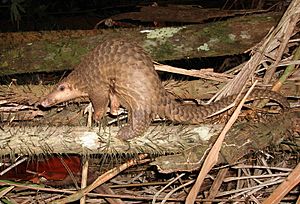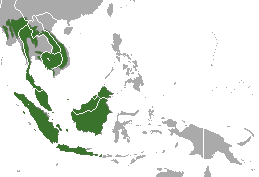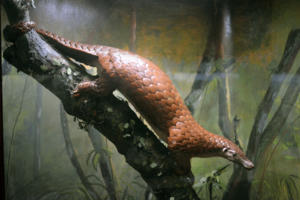Sunda pangolin facts for kids
Quick facts for kids Sunda pangolin |
|
|---|---|
 |
|
| Conservation status | |
| Scientific classification | |
| Genus: |
Manis
|
| Species: |
javanica
|
 |
|
| Sunda pangolin range | |
The Sunda pangolin (Manis javanica) is a special animal. It is also called the Malayan pangolin or Javan pangolin. It belongs to a family of animals called pangolins. Its name comes from a Malay word "pëngulin," which means "roller." This is because pangolins roll into a ball when they are scared.
These pangolins live in Southeast Asia. You can find them in countries like Myanmar, Thailand, Cambodia, and Vietnam. They also live on islands such as Borneo, Java, and Sumatra. Sunda pangolins like to live in forests. They can also be found in rubber and palm oil farms. They spend a lot of their time in trees.
Contents
What is a Sunda Pangolin?
Sunda pangolins have unique feet. The skin on their feet feels bumpy. They have strong, thick claws on their front feet. These claws help them dig into the ground. They use them to find ant nests or break into termite mounds.
Pangolins do not see very well. But they have an amazing sense of smell! They do not have teeth, but they have a very long, sticky tongue. This tongue helps them catch ants and termites. Unlike most mammals, pangolins are covered in rows of scales. These scales are made of keratin, like your fingernails. They also have some hair. The scales protect them from danger. Sunda pangolin scales are brown. Some even have white scales on their tails.
A Sunda pangolin's body can be about 40 to 65 centimeters (16 to 26 inches) long. Their tail can be 35 to 56 centimeters (14 to 22 inches) long. They can weigh up to 10 kilograms (22 pounds). Male pangolins are usually bigger than females. Female pangolins have small nipples that look like needles. They use these to feed their babies.
Scientists think pangolins have a very good sense of smell. This helps them find food. They use their noses and tongues a lot when they eat. Their hearing and eyesight are not as good. But their eyes are made to help them see well at night.
Life and Habits
Pangolins usually have one or two babies each year. They breed in the autumn. Female pangolins give birth in their winter dens. They often choose tree hollows in old forests for their dens. These hollows are strong and safe for raising young.
Mothers stay in these dens for longer when they have babies. They take care of their young for about three months. During this time, the mother pangolin does not travel far. She stays close to her baby while looking for food. Just before the young pangolin can live on its own, the mother and baby might be active during the day for short times.
Pangolins are usually shy and active at night. They live alone, though sometimes you might see a pair. When they feel scared, they roll up into a tight ball. This protects their soft belly. They are good at digging. They make burrows near termite mounds and ant nests. They line their burrows with plants to keep warm.
Sunda pangolins can get sick easily. They are sensitive to changes in temperature. Their main enemies are humans, tigers, and the clouded leopard. Sunda pangolins live in many parts of Southeast Asia.
Sunda Pangolins and People
Sunda pangolins are important to some local cultures. The Orang Asli people in Malaysia and the Kadazan, Dusun, Murut, and Rungus people in Sabah value them. The Kadazans even use pangolin scales to make special armor for their fighters.
Protecting Sunda Pangolins
Pangolins are among the most protected animals. This is because many are hunted and traded illegally. Sunda pangolins are hunted for their skin, scales, and meat. Their skin is used for clothes. Their scales are used in traditional medicine. Some people make rings from their scales to protect against sickness. Indigenous people also eat their meat.
Even though they are protected, illegal trade is a big problem. Many pangolins are bought by people in China. This has caused their numbers to drop very quickly. The Sunda pangolin is now considered critically endangered. This means they are in great danger of disappearing forever.
Since 2016, all eight types of pangolins are on a special list called CITES Appendix I. This list stops people from trading wild pangolins or their body parts across countries. China also made it illegal to trade pangolins in 2020.
Pangolins are also losing their homes. Their habitats are being destroyed. Because there are so few pangolins left, it is hard for scientists to study them. It is also hard to find them because they are active at night.
It has been hard to breed pangolins in zoos. This is because we don't know much about their habits. We also don't know much about how they grow. But recent studies show that baby pangolins can stop drinking milk after about 130 days. This information helps scientists protect pangolin dens. It also helps us learn more about these rare animals.
All eight types of pangolins are in danger. To help them, scientists, conservationists, and others need to work together. They can find new ways to protect pangolins and learn more about them.
Health and Pangolins
Scientists have studied pangolins and found that they can carry viruses. In 2019, a study showed that a virus similar to SARS-CoV was found in some Sunda pangolins. In 2020, researchers found a virus in pangolins that was very similar to SARS-CoV-2. This is the virus that causes COVID-19.
The pangolin virus was 99% similar to the human virus in one important part. This does not mean pangolins caused the human virus. But it shows that pangolins can carry viruses that are similar to human ones. Even though pangolins are protected by law in China, illegal hunting and trading still happens.
Trading Sunda pangolins can be risky. They might carry diseases that could spread to humans, farm animals, or other wild animals. Scientists have found diseases in pangolins when they are captured.




